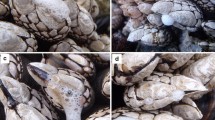Summary
In the laboratory, females of Gerris remigis foraging singly after being separated from a copulating male averaged 16 times longer to repel male copulatory attempts compared to repelling time when copulating (60 trials). In<10 min after separation, all females either became immobile at the edge (in 34% of all trials), or recopulated and either continued to forage (61%) or swam to the edge and became immobile (5%). Copulating females captured 85% of imitation prey, but single females, harassed by males, captured only 32% of prey.
During a census of 2 small streams, in the pools with swimming single males, >99% of all swimming females were copulating, <1% being single. Ninety seven percent of all single females were immobile at the edge, whereas only 11% of all pairs were at the edge. In pools without swimming single males, 32% of all single females were swimming, compared to <1% in pools with swimming males. Introductions of a male into 4 pools with a female swimming singly in each resulted in the females either becoming immobile at the edge or copulating. The 2 streams had a ♂:♀ sex ratio of 1.6:1, and 79% of all females were copulating during the census. Foraging, copulation and copulatory attempts continued at a reduced level during the night.
Thus in streams where male G. remigis are attempting to copulate, females can forage effectively only by carrying a copulating male who apparently repels copulatory attempts by other males.
Similar content being viewed by others
References
Barrows EM, Chabot MR, Michener CD, Snyder TP (1976) Foraging and mating behavior in Perdita texana. J Kans Entomol Soc 49:275–279
Eckwort GC, Ginsberg HS (1980) Foraging and mating behavior in Apoidea. Annu Rev Entomol 25:421–426
McLain KD (1981) Interference competition and mate choice in the soldier beetle, Chauliognathus pennsylvanicus. Behav Ecol Sociobiol 9:65–66
Matthey W (1975) Observations sur la reproduction de Gerris remigis Say. (Hemiptera, Heteroptera). Mitt Schweiz Entomol Ges 48:193–198
Parker GA (1970) Sperm competition and its evolutionary consequences in the insects. Biol Rev 45:525–567
Parker GA (1974) Courtship persistence and female-guarding as male time investment strategies. Behaviour 48:157–184
Rutowski RL (1982) Epigamic selection by males as evidenced by courtship partner preferences in the checkered white butterfly (Pieris protodice). Anim Behav 30:108–112
Rutowski RL, Alcock J (1980) Temporal variation in male copulatory behaviour in the solitary bee Nomadopsis puellae (Hymenoptera Andrenidae). Behaviour 73:175–188
Thornhill R (1976) Sexual selection and nuptial feeding behavior in Bittacus apicalis (Insecta: Mecoptera). Am Nat 110:529–547
Walker WF (1980) Sperm utilization strategies in nonsocial insects. Am Nat 115:780–799
Wilcox RS (1979) Sex discrimination in Gerris remigis: role of a surface wave signal. Science 206:1325–1327
Author information
Authors and Affiliations
Rights and permissions
About this article
Cite this article
Wilcox, R.S. Male copulatory guarding enhances female foraging in a water strider. Behav Ecol Sociobiol 15, 171–174 (1984). https://doi.org/10.1007/BF00292971
Received:
Accepted:
Issue Date:
DOI: https://doi.org/10.1007/BF00292971




